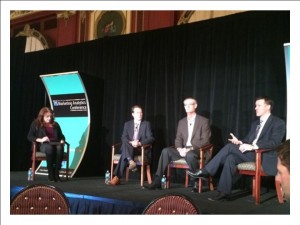In today’s world, leading your organization to faster, better decisions calls for skill, agility and resourcefulness. Increasingly, it also requires the use of analytics to meet changes in customer expectations brought about with social, mobile and the digitization of life.
 The lunch keynote at the DMA's Marketing Analytics Conference featured insights and practices from executives that have led their respective organizations to embrace analytics. Adele Sweetwood, VP of Marketing at SAS Institute, moderated this panel that included:
The lunch keynote at the DMA's Marketing Analytics Conference featured insights and practices from executives that have led their respective organizations to embrace analytics. Adele Sweetwood, VP of Marketing at SAS Institute, moderated this panel that included:
- Michael Parkerson, Chief Marketing & Strategy Officer, Blue Cross and Blue Shield of North Carolina
- Emmett Cox, SVP of Customer and Business Intelligence at BBVA Compass Bank
- Jeremy TerBush, VP of CRM and Customer Analytics at RCI/Wyndham Exchange
The Customer Journey
Adele kicked off the discussion with a short video about the customer journey and how it is increasingly influenced by new digital channels and technology. And that journey generates a wealth of information that helps marketers better understand and deliver excellence along that journey through the use of analytics.
And the customer journey begins long before we previously thought – we now know from research that our prospects and customers are 60% through their decision journey BEFORE they ever contact a vendor. Customers and prospects are downloading content, watching videos, and joining communities - truly across industries. And all those digital footsteps leave trails of data behind that marketers can use for insights.
Along that vein, one of Adele’s favorite quotes is, “whoever uses data better – wins.” To be sure, the availability of data has changed the dynamics in the enterprise. For Emmett, the biggest change has been blurred lines between analytics and marketing, which has helped marketing evolve the quality of its engagement.
Marketing analytics and the Customer Experience
When asked about the link between using marketing analytics and the customer experience, one consensus from the panel was that getting actionable insights and a single view of the customer can be the hardest part of making data matter. Emmett believes that it’s not the data per se, but what you do with the data that makes you stand out. For BCBSNC, Michael shared how the upheaval that came with the Affordable Care Act meant that they needed to use the data to ensure consumers were both competent in making health insurance choices and confident in their own ability to do it – a very customer centric approach to engaging health insurance customers that might surprise some.
And as an indicator of just how strategically important analytics are at BCBSNC, Michael added that, “We want to write history and not read about it, to shape the market and not just talk about it.
Fostering an Analytical Culture in Marketing
The panel explored the elements that drive the adoption of analytics, and in some ways catalyze that adoption, and how they relate to the culture of the organization. One of the most impactful lessons learned in building out an analytical culture is to reward constant testing and measuring—encouraging people to use the data and analytics to fail fast and innovate in their approaches.
Leadership plays a pivotal role in fostering an analytical culture in marketing. BCBSNC has merged analytics and strategy and the idea is that the insights derived from analytics are what drive (and should drive) strategy. In addition, BCBSNC encourages the development of customer-centric thinking by having the marketing team take on the personas identified in segmenting, which helps them enrich their planning discussions. At BBVA Compass, it begins with the hiring process, where they are looking for people that are curious and can blend both scientific objectivity and broad, creative thinking more closely linked with artists. And Adele shared how job postings at SAS are getting more descriptive in terms of addressing likes/dislikes and attributes of candidates as opposed to a simple listing of skills requirements.
Internal alignment around an analytically-driven culture also impacts the ability to become customer-centered. For Jeremy at Wyndham, driving progress and process can come down to the team you tap to help you move data and take the action to move forward. He further added that you’ve got to make friends with your IT counterpart to make your analytics work – and to further the necessary internal alignment so that people can speak both data and business.
Closing Thoughts:
Adele closed the discussion by asking for either a lesson learned or what’s next for their respective organizations.
- Michael suggested – don’t focus on regretting an action, nor should you look back and wish you’d done something. If you think something is going to help your customer or move your organization forward, then do it. You have the insights and perspectives that can help your company, so make sure you leverage them.
. - For Emmett, it’s about collecting data and not taking action on it. Don’t wait around wondering what the next shiny object in big data will be. There’s a tremendous amount of value with what you currently have, so don’t regret later that you didn’t use it.
. - From Jeremy’s perspective, it’s a matter of educating your peers on the value of analytics and how it will positively impact the organization. He suggests that you focus on getting everyone on board with what analytics will deliver and providing progress reports along the way.
. - And Adele concurred with all of the panelists final thoughts and added that you should take steps to have fun along the way – otherwise it’s not worth doing it.
.
-----------
This post originally appeared on the Advance, the official blog of the Direct Marketing Association.
